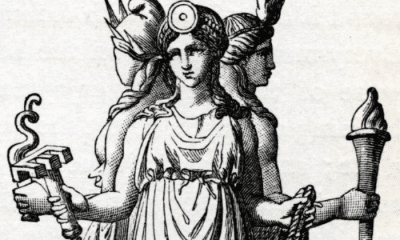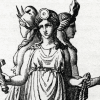Greek
Greek Astrology: Constellations and Their Names
Have you ever wondered how the twelve signs of the zodiac were named? Keep reading to find out how Greek mythology influenced this ancient tradition!
If you have an interest in astrology, you are familiar with the twelve zodiac signs. Based on constellations, they track the movement of stars and planets that are believed by some to influence people’s lives.
The twelve signs of the zodiac divided the sky into equal sections that moved in a predictable way. They were used by ancient Greeks to navigate, mark the passage of time, and in divination.
The Greeks also had myths that explained how these constellations came to be. Many were minor figures in well-known myths while others were symbols of great gods and their powers.
How did the Greeks think of such fanciful images as Capricorn and Virgo, though? The answer to that question lies in how one of many cultures of the ancient world saw the stars.
The Greek Constellations of Astrology
The twelve signs of the zodiac appear in Greek mythology. In modern usage, they are most often referred to by their Latin names.
The myths that tell of how these and other constellations came to be placed in the sky are often not the most well-known. They feature very familiar images, though.
The signs of astrology, and the constellations they are associated with, each take the form of a person or animal. Greek mythology had explanations for how these forms came to be seen in the night sky.
Aries, the first sign of the zodiac, is represented by a ram. According to legend, this was Chrysomallus, the ram whose golden fleece was the subject of the hero Jason’s epic quest.
Taurus, the bull, commemorated Zeus’s abduction of Europa. The king of the gods took the form of a bull to steal the princess from Phoenicia and take her to Crete.
Gemini, the sign of the twins, represented Castor and Pollux. Known as the Dioscuri, one was the son of Zeus who begged that his mortal brother be granted immortality as a star upon his death.
The crab sign, Cancer, was in the image of the crab Karkinos that fought against Heracles with the Hydra. When Heracles crushed the crab beneath his foot, Hera placed it in the stars.
Another enemy of Heracles that Hera memorialized in this way was the Nemean Lion. It became Leo, the fifth astrological sign.
There were many ancient myths for how Virgo, the maiden, earned her place in the stars. According to one popular legend, she was the last person to abandon the world at the end of the Silver Age.
The balancing scales that represent Libra are the only astrological constellation that takes the form of an object instead of a person or animal. They are a symbol of Themis, the goddess of divine and natural law.
According to one myth, Leto sent a scorpion to kill the giant hunter Orion after he insulted her daughter, Artemis. When the creature succeeded, she placed it in the sky as Scorpio.
Sagittarius, the archer, is typically represented as a centaur. This is Chiron, a friend of the gods who was accidentally killed by one of Heracles’ poisoned arrows and placed among the stars by Zeus.
The sign of Capricorn is often shown in modern art as a goat, but more often takes the form of a half-goat, half-fish creature. The Greeks had many myths to explain this form.
The cupbearer of the gods was the inspiration for Aquarius, the water-bearer. Ganymede was a beautiful boy who was taken to Olympus by Zeus to keep him close and preserve his youth forever.
The final sign, Pisces, is in the form of two fish. According to legend, Aphrodite and Eros transformed themselves into two large fish to escape from the giant Typhon when he attacked the gods.
While the Greek myths and Roman names are well-known in connections to the astrology constellations, however, their roots lay much farther back than these stories.
My Modern Interpretation
In the Western world, art and symbolism has referenced Greek and Roman myths and legends in association with the zodiac. The Greek myths, however, were a later addition to the horoscope.
Around the world, cultures used constellations to track the passage of time and to navigate. Because certain stars in the sky are brighter and close to one another, they were often included in similar constellations by different cultures.
The hooked shape of the constellation Scorpio, for example, reminded the Greeks of a scorpion’s tale. In China, it was seen as a part of a dragon while in the Hawaiian islands it was said to be the fishhook of the demigod Maui.
The Greeks were not the only culture to imagine divine images in the sky, nor were they the first to give many familiar constellations the shapes we know them by today.
The current forms of the Western constellations and the use of the zodiac were introduced to Greece in the 4th century BC. They were taught to the people of Athens by Eudoxus of Cnidus, a native of what is now the country of Turkey and became more well-known in the 2nd century AD through the Egyptian scholar Ptolemy.
Eudoxus had learned what he knew of astrology not from earlier Greek scholars, but from traditions of the Near East. Many of the constellations associated with astrology originated in Babylon.
There is some evidence that Babylonian astronomers may have devised some of the constellations, including Gemini and Cancer, as early as the 1st millennium BC. About a hundred years before Eudoxus taught in Athens, they devised an astrological calendar based around these constellations to divide the year into twelve equal months.
Because the Greeks adopted the Babylonian astrology and constellations almost directly, the images used to represent them were not original to Greek culture. Instead, new myths were created to retroactively write the constellations into Greek mythology.
The constellation Cancer, for example, was seen as a scarab beetle by the Egyptians who taught Ptolemy the zodiac. Unfamiliar with this desert insect, the Greeks reimagined it as a crab that had faithfully served Hera as a new character in a well-known story.
Other images were harder to fit into Greek belief. The hybrid form of Capricorn was based on a Babylonian god so the Greeks were never able to fully fit the unusual creature into their existing mythology.
Because Greek and Roman art and writing survived in many parts of Europe, their versions of the constellations and astrology were passed down into the modern era. While the astrology constellations were invented in the Near East, they are now thought of as a legacy of the Greco-Roman world.
In Summary
Many constellations in modern astronomy were known to the ancient Greeks. Often, the constellations were said to be images of figures and symbols from Greek mythology.
These included the twelve constellations that were used to create the zodiac. In astrology, the constellations are believed to be signs that roughly correspond to a calendar month and influence the course of people’s lives.
Many of the constellations were said by the ancient Greeks to be mythological figures. Gemini, the twins, for example were Castor and Pollux while Sagittarius was the centaur Chiron.
Other signs were based on symbols for the gods. The scales that symbolize Libra, for example, represented Themis in her role as a goddess of law.
While the images associated with the astrology constellations are known by most people in the Western world as Greco-Roman signs, this was not actually the origin of the zodiac.
The zodiac and the constellations that it was made of were adopted by the Greeks from Babylonian culture. Introduced by Anatolian and Egyptian scholars, they were based originally on images and deities from Near Eastern culture.
Because the astrology constellations were adopted into Greek and Roman culture, they remained well-known in Europe through the modern era. While their Mesopotamian origins are largely forgotten, they remain influential in modern thought and culture.



